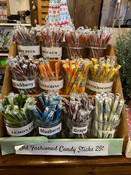VT 251: The Orphan Towns
- donnaramadishes
- Jan 31
- 6 min read
Cumulative Official Town Count | Unofficial Town Count |
252 | 62 |
The towns in this (last) VT 251 write-up are the orphans not covered previously, but do not assume that means they are less dear or worthy; it is simply just the way the blog-post cookies crumbled. That said, I present to you the towns of GEORGIA, MILTON, WINOOSKI, POULTNEY, WELLS, MIDDLETOWN SPRINGS, & IRA. On a map they fall into two distinct areas: just outside Burlington (in the north) and south-central-west (ish). If I were to generalize, I'd say that the towns covered here which are near Burlington offer less of interest to explorers (but plenty to residents), while the ones further south are more quintessential Vermont towns; with the rural charm, buildings, and landscapes idle visitors are likely to find endearing.
GEORGIA
Georgia, VT is a small rural town of less than 5,000 (as of 2020) which may not have a lot to offer a visitor, but has enough for its residents. Chartered in 1763 by Benning Wentworth, the governor and commander-in-chief of New Hampshire (still under the British crown), the town, like the majority of towns in VT, was part of the New Hampshire Grants. Georgia was not settled until after the end of the Revolutionary War (in 1785) when its first settler, William Farrand from Bennington, built a small cabin there. The town has been a small farm community pretty much from the beginning. It is less than a half-hour from Burlington, has a Plains area (I think -- get it? Plains, Georgia??), and has the municipal offerings one would want in a hometown.
MILTON
The Town of Milton, VT was chartered on June 8, 1763, also by Governor Benning Wentworth of New Hampshire, and is located roughly 14 miles north of Burlington. With just under 12,000 residents, it is the 8th largest community in Vermont. the Town was not settled until the end of the Revolutionary War (1782), with farming and timber being the primary industries. Checkerberry Green was where the Town House (town hall) was located, and is memorialized as a cemetery these days. It seems to me that, like many towns around Burlington, Milton is more a town for people to live in than for visitors to explore.
WINOOSKI
Winooski, VT, which borders Burlington, is one of ten cities in Vermont and has more of an "urban feel" than most most of the others, with its diversity (yes, you read that right!) and abundance of culinary offerings. In fact, Winooski is the most densely populated municipality in northern New England (Maine, New Hampshire, and Vermont), with a population of around 8,000 in a mere 1.5 square miles. I think of it as the Brooklyn (NY) of the state, but that's just me. The downtown, which abuts a large town green (traffic circle), offers a variety of restaurants (my focus when I visited there), retail shops, a craft brewery (Four Quarters Brewing), a happening nightlife (so I've heard), and a lovely promenade overlooking the Winooski River. Historically, Winooski was home to the Abenake tribe starting in roughly 750 CE although there is evidence of at least one neolithic family living in the area roughly 5,000 years ago. In 1763, the area was chartered and known as Winooski Falls before becoming a city in 1922.
Should you find yourself in need of (or desire) some sustenance in Winooski, here are some places to consider:
Onion City Chicken & Oyster -- for oysters & fried chicken
Misery Loves Company -- a market with delicious prepared options like sandwiches and soups
Our House Bistro -- for all your mac & cheese cravings
Four Quarters Brewing -- when you need some tasty food and local craft beer
Scout -- great for coffee and either ice cream or a baked treat
Waterworks -- For a nice dinner with a view!
POULTNEY
Poultney, VT is a small town of about 3,000 (in 2023) which borders New York State. Home of the now-defunct Green Mountain College (shuttered its doors in 2019), the town brings in many visitors as it includes the lovely Lake Saint Catherine. Poultney is one of the towns located in Vermont's Stone Valley, and its history can be explored along an historic trail, or as you ride a bike or walk along a rail trail where stone used to be exported. Lake St. Catherine appeals to boaters, swimmers, and paddlers in the summer with its state park and numerous private docks, camps, and beaches. While the town doesn't exude charm, but does have a really nice looking used-book store and the Original Vermont Store (no relation to The Vermont Country Store). Just down the road is East Poultney, which is teeny but seems to be the historic town center, with a home of an ex-slave revolutionary abolitionist and a tavern which once housed Horace Greeley!
WELLS
Wells, VT is an iconic cute, tiny town (surprisingly with no town sign) of roughly 1,200, complete with a town green, great country store, and (they argue) "the most beautiful little library in the world." In the town of Wells, one can find peace and solitude in nature at Lakeside Park, a lovely stretch of lakeshore and woodland on Lake St. Catherine, which is the second-largest lake entirely in Vermont. It was (and still is) a stopping place for visitors (and residents alike) and it is reputed that Ethan Allen was a frequent visitor who came to hunt and fish in around around the lake. Wells was chartered in 1761 by Benning Wentworth, and has maintained its rural character since it was formed in 1771 (when it became an official town). The town embodies the quaint character that folks think of when they think about small town Vermont, and the village (center) has been designated an historic district on the State Register of Historic Places!
MIDDLETOWN SPRINGS
Middletown Springs, VT is a tiny cute town of about 750 residents without much going on, but with lots of town pride. There is a lovely large town green with a monument to fallen soldiers which is surrounded by the church and historical society buildings. The town was founded (and aptly named Middletown) in 1784 when citizens of the towns of Ira, Poultney, Wells, and Tinmouth petitioned the Vermont legislature to create a new town bounded by the ridges that prevented them from attending meetings and worship services in their original towns. Defined by the encircling mountains, Middletown became one of Vermont’s few uniquely shaped communities. As the current name suggests, there was a time when the town's water (from the Poultney River) was said to have restorative properties, and in 1885 the name was thus changed from Middletown to Middletown Springs. Sadly, those springs (and their related hotels/ businesses) are now gone, with stalwart farming keeping the community going. There is Mahar Maple farm to visit, although we couldn't find it and gave up/ turned around apparently just before and across the road (at what turned out to be Mystic Moon Llamas, which made a nice diversion). If you're seeking cute towns as you drive on dirt roads through rural Vermont, keep your eyes open as you drive through/ past Middletown Springs; or, maybe get yourself some maple and visit the llamas!
IRA
Ira, VT is another tiny Vermont town, with a population of 371 (in 2023). It was named for Ira Allen, brother of Ethan Allen, who fought with the Green Mountain Boys in the Revolutionary War, although there is no evidence Ira Allen cared about the town at all. It is reputed that the town never had an official sanction (i.e. charter) for its existence (although some say there was one, which was lost when the capitol in Montpelier burned), and that its first residents were squatters. That said, the town was organized in 1779, and then granted by the state in 1780 (without the original charter). Rest assured, the charter is now in order. (Phew!) As a visitor, there isn't much to see other than the mountain views of the Taconics (no commerce but a church or two, of course), but the historic Town House (town hall) is pretty cool.
And that, folks, concludes my (and your virtual) tour of every official town (on my list) in the state of Vermont. Hope you've enjoyed the ride!






































































































Comments